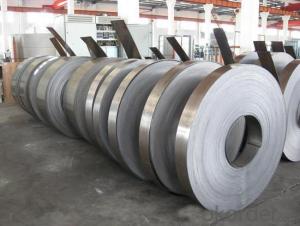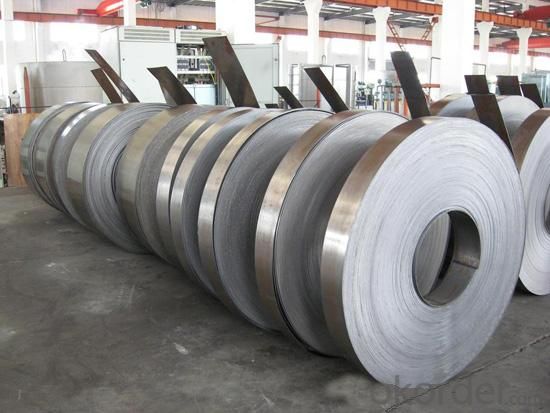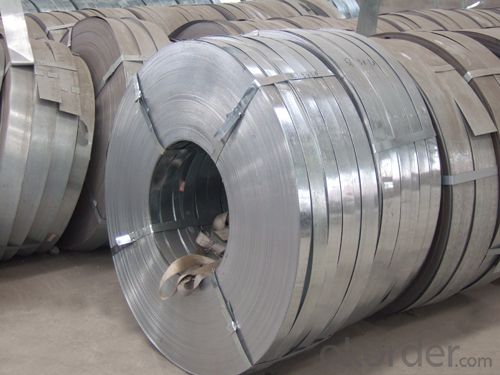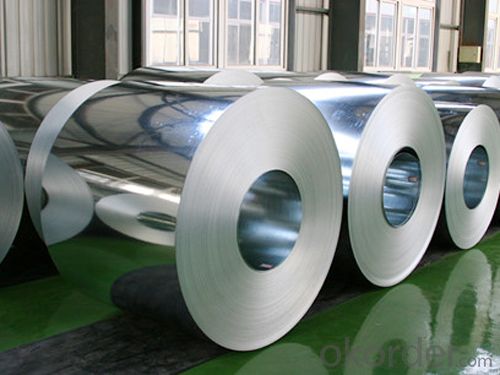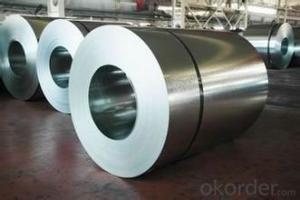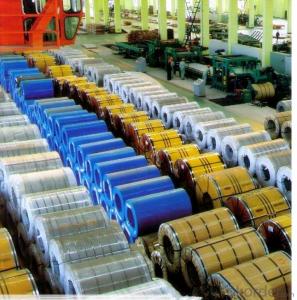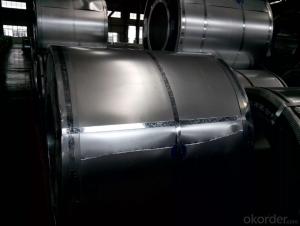Galvanized Steel Strips with Width 610mm
- Loading Port:
- China main port
- Payment Terms:
- TT OR LC
- Min Order Qty:
- 25 m.t.
- Supply Capability:
- 20000 m.t./month
OKorder Service Pledge
OKorder Financial Service
You Might Also Like
1.Structure of Hot-Dip Galvanized Steel Strips Description:
Hot-dip galvanized steel coils are available with a pure zinc coating through the hot-dip galvanizing process. It offers the economy, strength and formability of steel combined with the corrosion resistance of zinc. The hot-dip process is the process by which steel gets coated in layers of zinc to protect against rust. It is especially useful for countless outdoor and industrial applications. Production of cold formed corrugated sheets and profiles for roofing, cladding, decking, tiles, sandwich walls, rainwater protective systems, air conditioning duct as well as electrical appliances and engineering.
2. Main Features of the Hot-Dip Galvanized Steel Strips:
• Excellent process capability
• Smooth and flat surface
• Workability, durability
• Excellent anticorrosive property
• High strength
• Good formability
• Good visual effect
3. Hot-Dip Galvanized Steel Strips Images

4. Hot-Dip Galvanized Steel Strips Specification
1) Capacity: about 15,000 tons per month for sheet product.
2) Standard: JIS G3302 1998, ASTM A653M/A924M 2004, all according to the customer's request
3) Thickness: 0.13mm-0.5mm
4) Width: 400mm-1000mm
5) Length: We can adjust the length according to your request
6) Zinc Coating Weight: 60g/m2-275g/m2
7) Raw Materials: Galvanized steel sheet and Pre-painted galvanized steel sheet
8) Spangle: Regular spangle, minimized spangle and zero spangle
9) Hardness: Full hard, normal
Thickness | Width | Length | ZincCoating Weight | Color Series |
0.13mm-1.0mm | 400mm-1000mm | As your request | 60g/m2-275g/m2 | RAL,or other series |
5.FAQ of Hot-Dip Galvanized Steel Strips
We have organized several common questions for our clients,may help you sincerely:
1. How to guarantee the quality of the products?
We have established the international advanced quality management system,every link from raw material to final product we have strict quality test;We resolutely put an end to unqualified products flowing into the market. At the same time, we will provide necessary follow-up service assurance.
2. How long can we receive the product after purchase?
Production period is 30 days. And we’d prefer you can give us more time to book vessel.
3. What’s the usage of cold rolled steel coil?
Auto manufacture, Oil drum, Transformer's tank panel, Furniture etc.
- Q: I thought it was STAINLESS STEEL! I have stainless steel can openers spatulas that are rusty. What's up with that? did you know that braces on people's teeth are made of stainless steel? That's why they call people metal-mouth. I used to have braces.
- Stainless steel is manufactured in a variety of different alloys. The percent of Chrome and other metals determine which alloy of stainless is produced. Not all versions of stainless is rust proof, just rust resistant. Not knowing which version of stainless steel you are discussing makes an exact answer difficult. Most stainless steel needs also be exposed to oxygen to retain it's 'stainless' properties. There are also version of steel, Monel and Inconel, that most would consider 'stainless'. Salt water will rapidly affect most versions of stainless with what is called cloride stress corrosion which cause a failure of the lattice structure of the metal. Generally, some stainless steel with a lower chrome content may appear to have discoloration that appears to be rust.
- Q: What are the different methods of testing steel coils for quality control?
- There are several methods commonly used to test steel coils for quality control. These methods ensure that the steel coils meet the required specifications and standards. 1. Visual Inspection: This is the most basic method of testing steel coils. It involves a thorough visual examination of the coils for any surface defects such as scratches, dents, or irregularities. Visual inspection helps identify any visible defects in the material. 2. Dimensional Measurement: Another important method is dimensional measurement. This involves using various tools like calipers, micrometers, or laser measuring devices to assess the dimensions of the steel coils. The measurements are compared against the specified tolerances to ensure they meet the required standards. 3. Hardness Testing: Hardness testing determines the resistance of the steel coils to indentation or penetration. It helps assess the strength and durability of the material. Common hardness testing methods include Rockwell, Brinell, and Vickers hardness tests. 4. Tensile Strength Testing: Tensile strength testing measures the maximum amount of tensile stress a steel coil can withstand before breaking or deforming. This test helps determine the strength and elasticity of the material and ensures it meets the required specifications. 5. Chemical Analysis: Chemical analysis involves testing the composition of the steel coils to verify if they contain the desired amount of specific elements. This is crucial for ensuring the coils are made from the correct grade of steel and comply with the required chemical composition standards. 6. Coating Thickness Measurement: In case the steel coils have a protective coating, it is important to measure the thickness of the coating. This is typically done using non-destructive testing methods like magnetic induction or eddy current testing. The coating thickness is compared against the specified requirements to ensure it provides adequate protection. 7. Surface Roughness Measurement: Surface roughness testing assesses the smoothness or roughness of the steel coil's surface. This is done using instruments like profilometers or roughness testers. Surface roughness testing helps ensure the coils meet the required surface finish standards. 8. Ultrasonic Testing: Ultrasonic testing utilizes high-frequency sound waves to detect internal defects such as cracks, voids, or inclusions within the steel coils. It is a non-destructive testing method that provides valuable information about the coil's structural integrity. 9. Magnetic Particle Inspection: This method is used to identify surface and near-surface defects in steel coils. Magnetic particles are applied to the surface, and any magnetic leakage caused by defects is detected using magnetic sensors. This technique is particularly effective for detecting cracks and other surface abnormalities. By employing a combination of these testing methods, manufacturers can ensure that the steel coils produced meet the required quality standards and are suitable for their intended applications.
- Q: How are steel coils used in the manufacturing of railroads?
- Steel coils are used in the manufacturing of railroads to produce rails, which form the tracks that trains run on. These coils are rolled into long, straight sections and then shaped into the required rail profile. The rails are then cut to the desired length and undergo various processes, such as heat treatment and finishing, to enhance their strength and durability. Overall, steel coils are a crucial raw material in the creation of reliable and robust railroad infrastructure.
- Q: Why people prefer prefabricated buildings these days? Recently my friend has told me that he is going to owe a steel house so I was just thinking are these steel structures really durable and cheaper than concrete structures?
- It really depends upon the environment and the construction techniques used. Steel that is painted or coated will without maintenance eventually rust. I would expect this tendency to be exacerbated in a humid or shore environment. Heat may tend to cook a steel house and the structure does not add much thermal mass. Construction techniques tend to be fairly quick a part of the construction is essentially prefabricated. Work done in a factory will almost always be cheaper than work done in the field, all things being equal. Concrete can be fairly hi tech with lots of equipment or as seen in many parts of the world fairly low tech with lots of laborers. It is easy to change the characteristics of concrete depending upon how it is mixed, reinforced, and treated during the curing process. Because it is applied in a relatively fluid state it can flow around obstructions like bedrock and be formed up into interesting shapes. A concrete structure can be cooler as it provides thermal mass, and a heat sink. It's resulting rigidity may make it more subject to earthquakes than steel. We do really need to be smarter in constructing our homes to make them fit the land and not only the general environment but our particular micro environment.
- Q: What are the different methods of protecting steel coils from corrosion?
- Some common methods of protecting steel coils from corrosion include applying a protective coating or paint, using corrosion inhibitors, implementing cathodic protection systems, and storing the coils in a controlled environment with low humidity and proper ventilation.
- Q: What are the uses of galvanized steel coils?
- Galvanized steel coils have a wide range of uses in various industries due to their unique properties. Here are some common uses of galvanized steel coils: 1. Construction: Galvanized steel coils are widely used in the construction industry for various applications. They are used to manufacture roofing sheets, wall panels, and structural components. The galvanized coating helps to protect the steel from corrosion, extending its lifespan and ensuring durability in harsh weather conditions. 2. Automotive industry: Galvanized steel coils are used in the automotive industry for manufacturing different parts and components. These coils are used to manufacture body panels, chassis, and other structural parts of vehicles. The galvanized coating provides excellent corrosion resistance, which is crucial for the longevity of automobiles. 3. Appliances: Galvanized steel coils are used in the production of various household appliances, such as refrigerators, washing machines, and air conditioners. The coils are used to manufacture the outer panels and cabinets of these appliances, providing them with a strong and durable structure. 4. Agriculture: Galvanized steel coils find applications in the agriculture sector as well. They are used to manufacture agricultural equipment, such as grain storage silos, irrigation systems, and livestock enclosures. The galvanized coating protects the steel from rust and corrosion, ensuring the safety and longevity of these agricultural structures. 5. Industrial applications: Galvanized steel coils are widely used in various industrial applications. They are used for manufacturing ductwork, ventilation systems, and industrial piping. The galvanized coating helps to resist chemicals, moisture, and other environmental factors, making it an ideal choice for industrial environments. 6. Electrical industry: Galvanized steel coils are used in the electrical industry for manufacturing electrical enclosures, conduit pipes, and cable trays. The galvanized coating provides excellent protection against corrosion and ensures the safety and durability of electrical installations. 7. Furniture manufacturing: Galvanized steel coils are used in the furniture manufacturing industry for producing furniture frames, shelves, and cabinets. The galvanized coating adds strength and durability to these furniture pieces, making them long-lasting and resistant to corrosion. Overall, galvanized steel coils have a wide range of uses in various industries due to their excellent corrosion resistance, durability, and strength. They are a cost-effective and reliable choice for applications that require protection against rust and environmental factors.
- Q: How are steel coils used in the production of industrial machinery?
- Steel coils are used in the production of industrial machinery as they provide a strong and durable material for constructing various components such as frames, gears, and shafts. These coils are typically formed into different shapes and sizes, allowing manufacturers to create customized parts that meet specific design and performance requirements. The high strength and versatility of steel make it an ideal choice for ensuring the reliability and longevity of industrial machinery.
- Q: is red steel any good??????? not sure im really impressed but im not really into fighting games but it looks cool.... so whats your views guys???????anyone bored of smooth moves yet?anyone think the new sonic is bit cra ppy !!!!!!!!!!! darn them any new goooood games coming oput on the wii??
- Trauma center is awesome. Red steel isn't bad. Same as any other FPS except with a pointer... It's no half life, but its not terrible. Multiplayer is highly entertaining though. Especially if you can get four people playing mystery mode. Trust me, its worth the effort of getting them together. Like the other guy said, rent it. I wouldn't buy it.
- Q: How are steel coils protected from condensation?
- Steel coils are typically protected from condensation by applying a thin layer of oil or another corrosion-resistant coating to the surface. This acts as a barrier, preventing moisture from coming into direct contact with the steel and minimizing the risk of condensation forming. Additionally, the coils are often stored in a controlled environment with proper ventilation to minimize humidity levels and prevent condensation from occurring.
- Q: How do steel coils contribute to sustainability in manufacturing?
- Steel coils contribute to sustainability in manufacturing in several ways. Firstly, steel is a highly recyclable material, meaning that steel coils can be easily recycled and reused, reducing the need for new steel production and conserving natural resources. Additionally, steel is known for its durability and strength, resulting in longer-lasting products and reduced waste. Steel coils also play a vital role in energy-efficient manufacturing processes, as they can be easily formed into various shapes and sizes, optimizing material usage and minimizing energy consumption. Furthermore, steel's versatility makes it suitable for a wide range of applications, allowing manufacturers to create more sustainable products across industries. Overall, steel coils contribute to sustainability by promoting resource conservation, waste reduction, energy efficiency, and the production of durable and eco-friendly products.
Send your message to us
Galvanized Steel Strips with Width 610mm
- Loading Port:
- China main port
- Payment Terms:
- TT OR LC
- Min Order Qty:
- 25 m.t.
- Supply Capability:
- 20000 m.t./month
OKorder Service Pledge
OKorder Financial Service
Similar products
Hot products
Hot Searches
Related keywords
